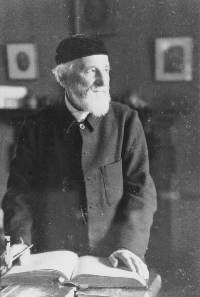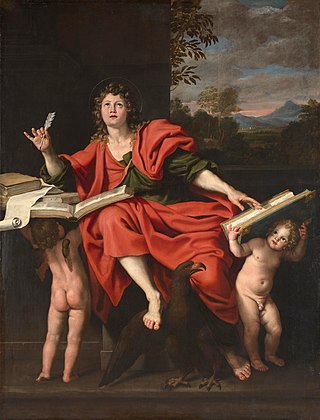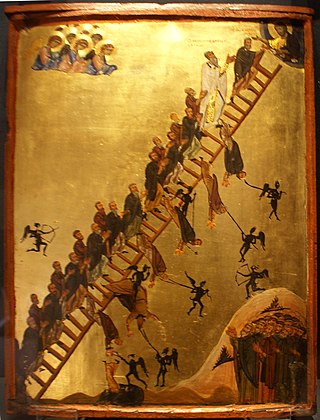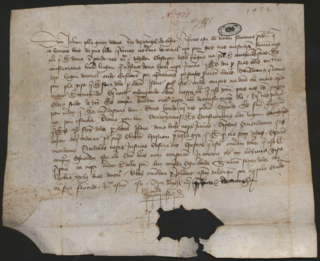- Johannine epistles
- Johannine Comma
- Johannine community
- Johannine script
- Johannine baroque , Portuguese architecture style

Edwin Abbott Abbott was an English schoolmaster, theologian, and Anglican priest, best known as the author of the novella Flatland (1884).

The First Epistle of John is the first of the Johannine epistles of the New Testament, and the fourth of the catholic epistles. There is no scholarly consensus as to the authorship of the Johannine works. The author of the First Epistle is termed John the Evangelist, who most modern scholars believe is not the same as John the Apostle. Most scholars believe the three Johannine epistles have the same author, but there is no consensus if this was also the author of the Gospel of John.

The Gospel of John is the fourth of the four canonical gospels in the New Testament. It contains a highly schematic account of the ministry of Jesus, with seven "signs" culminating in the raising of Lazarus and seven "I am" discourses culminating in Thomas' proclamation of the risen Jesus as "my Lord and my God". The gospel's concluding verses set out its purpose, "that you may believe that Jesus is the Christ, the Son of God, and that believing you may have life in his name."

The Second Epistle of John is a book of the New Testament attributed to John the Evangelist, traditionally thought to be the author of the other two epistles of John, and the Gospel of John. Most modern scholars believe this is not John the Apostle, but in general there is no consensus as to the identity of this person or group.

The Third Epistle of John is the third-to-last book of the New Testament and the Christian Bible as a whole, and attributed to John the Evangelist, traditionally thought to be the author of the Gospel of John and the other two epistles of John. The Third Epistle of John is a personal letter sent by "the elder" to a man named Gaius, recommending to him a group of Christians led by Demetrius, which had come to preach the gospel in the area where Gaius lived. The purpose of the letter is to encourage and strengthen Gaius, and to warn him against Diotrephes, who refuses to cooperate with the author of the letter.
A comma (,) is a type of punctuation mark.
An elder is someone with a degree of seniority or authority.
Paraclete is a Christian biblical term occurring five times in the Johannine texts of the New Testament. In Christian theology, the word commonly refers to the Holy Spirit and is translated as 'advocate', 'counsellor' or 'helper'.
Yohananיוֹחָנָן, sometimes transcribed as Johanan is Hebrew male given name that can also appear in the longer form of יְהוֹחָנָן, meaning "YHWH is gracious".

The authorship of the Johannine works has been debated by biblical scholars since at least the 2nd century AD. The debate focuses mainly on the identity of the author(s), as well as the date and location of authorship of these writings.

John 21 is the twenty-first and final chapter of the Gospel of John in the New Testament of the Christian Bible. It contains an account of a post-crucifixion appearance in Galilee, which the text describes as the third time Jesus had appeared to his disciples. In the course of this chapter, there is a miraculous catch of 153 fish, the confirmation of Peter's love for Jesus, a foretelling of Peter's death in old age, and a comment about the beloved disciple's future.

The Johannine epistles, the Epistles of John, or the Letters of John are the First Epistle of John, the Second Epistle of John, and the Third Epistle of John, three of the catholic epistles in the New Testament. In content and style they resemble the Gospel of John. Specifically in the First Epistle of John, Jesus is identified with the divine Christ, and more than in any other New Testament text, God's love of humanity is emphasised.

Johannine literature is the collection of New Testament works that are traditionally attributed to John the Apostle, John the Evangelist, or to the Johannine community. They are usually dated to the period c. AD 60–110, with a minority of scholars, including Anglican bishop John Robinson, offering the earliest of these datings.
John 16 is the sixteenth chapter of the Gospel of John in the New Testament of the Christian Bible. It records Jesus' continued farewell discourse to his disciples, set on the last night before his crucifixion. In this chapter, Jesus speaks about the work of the Holy Spirit, the joy of the believers and his victory over the world. The book containing this chapter is anonymous, but early Christian tradition uniformly affirmed that John composed this Gospel.

The term Johannine community refers to an ancient Christian community which placed great emphasis on the teachings of Jesus and his apostle John.

Eternal life traditionally refers to continued life after death, as outlined in Christian eschatology. The Apostles' Creed testifies: "I believe... the resurrection of the body, and life everlasting." In this view, eternal life commences after the second coming of Jesus and the resurrection of the dead, although in the New Testament's Johannine literature there are references to eternal life commencing in the earthly life of the believer, possibly indicating an inaugurated eschatology.
John Painter, is an Australian academic, New Testament scholar, and Christian theologian specializing in Johannine literature. He is currently Professor of Theology at Charles Sturt University in Canberra.

By the end of the 20th century, the theological importance of the Holy Spirit in Johannine literature had been accepted by New Testament scholars, overshadowing the early 20th-century views that minimized its role in the writings of John.

The name John is prominent in the New Testament and occurs numerous times. Among Jews of this period, the name was one of the most popular, borne by about five percent of men. Thus, it has long been debated which Johns are to be identified with which.

Johannine script was a historical style of handwriting used in the Portuguese Royal Chancery starting around the reign of John I (1385–1433) that was used until the reign of Manuel I (1495–1521). It is, thus, a national variation of chancery hand, a form of blackletter.